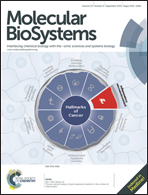Can hydroxylamine be a more potent nucleophile for the reactivation of tabun-inhibited AChE than prototype oxime drugs? An answer derived from quantum chemical and steered molecular dynamics studies†
Abstract
Organophosphorus nerve agents are highly toxic compounds which strongly inhibit acetylcholinesterase (AChE) in the blood and in the central nervous system (CNS). Tabun is one of the highly toxic organophosphorus (OP) compounds and is resistant to many oxime drugs formulated for the reactivation of AChE. The reactivation mechanism of tabun-conjugated AChE with various drugs has been examined with density functional theory and ab initio quantum chemical calculations. The presence of a lone-pair located on the amidic group resists the nucleophilic attack at the phosphorus center of the tabun-conjugated AChE. We have shown that the newly designed drug candidate N-(pyridin-2-yl)hydroxylamine, at the MP2/6-31+G*//M05-2X/6-31G* level in the aqueous phase with the polarizable continuum solvation model (PCM), is more effective in reactivating the tabun-conjugated AChE than typical oxime drugs. The rate determining activation barrier with N-(pyridin-2-yl)hydroxylamine was found to be ∼1.7 kcal mol−1, which is 7.2 kcal mol−1 lower than the charged oxime trimedoxime (one of the most efficient reactivators in tabun poisonings). The greater nucleophilicity index (ω−) and higher CHelpG charge of pyridinylhydroxylamine compared to TMB4 support this observation. Furthermore, we have also examined the reactivation process of tabun-inhibited AChE with some other bis-quaternary oxime drug candidates such as methoxime (MMB4) and obidoxime. The docking analysis suggests that charged bis-quaternary pyridinium oximes have greater binding affinity inside the active-site gorge of AChE compared to the neutral pyridinylhydroxylamine. The peripheral ligand attached to the neutral pyridinylhydroxylamine enhanced the binding with the aromatic residues in the active-site gorge of AChE through effective π–π interactions. Steered molecular dynamics (SMD) simulations have also been performed with the charged oxime (TMB4) and the neutral hydroxylamine. From protein–drug interaction parameters (rupture force profiles, hydrogen bonds, hydrophobic interactions), geometry and the orientation of the drug candidates, the hydroxylamine is suggested to orchestrate the reactivation process better than TMB4. Furthermore, the calculated log P values show the effective penetration of the neutral drug candidate through the blood–brain barrier. The toxicity measurements and the IC50 values (a measure of the intrinsic affinity toward AChE) suggest that the pyridinylhydroxylamine compound could have similar toxic behavior compared to the prototype oxime antidotes used for reactivation purposes. The newly designed pyridinylhydroxylamine drug candidate can be an effective antidote both kinetically and structurally to reactivate the tabun-inhibited enzyme.


 Please wait while we load your content...
Please wait while we load your content...